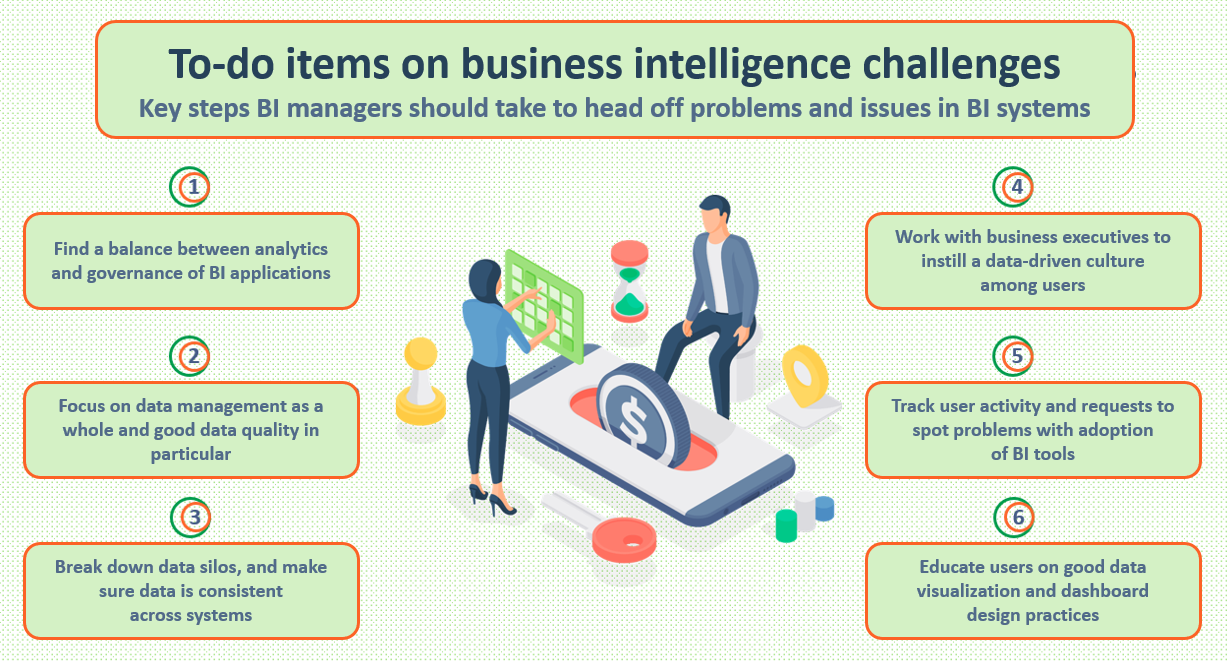
BI teams face various technical and project management challenges on deployments. Here are the top BI challenges, with some advice from experienced BI people, on how to address them.
As businesses of all sizes rush to make sense of the growing volumes of data they’re collecting, they face a variety of business intelligence challenges that complicate efforts to make BI processes productive, effective, and useful.
The challenges are shaped by multiple factors, including diverse data infrastructures, data management issues, new types of BI capabilities and varying levels of data literacy in the workforce. On the one hand, BI teams must ensure that proper data governance and security protections are put in place; on the other, they need to demonstrate how BI can benefit workers, including less data-literate ones.
Another set of BI challenges centers around changes in the ways that business intelligence tools are being used in organizations to guide business decisions.
Traditional BI usually involves curated data and IT-driven applications. The traditional approach delivers information to business users through dashboards, reports and portals with well-defined workflows. In contrast, modern BI initiatives are often driven by business units using self-service BI, data preparation and data visualization tools to hunt for information.
In many cases, the challenges start with getting approval and funding for a business intelligence program and developing a solid BI strategy that meets business requirements and can deliver the promised return on investment. In addition to conventional querying and reporting, BI strategies often need to incorporate mobile BI, real-time BI and analytics, augmented analytics, and other specialized applications, further increasing the deployment and management challenges.
While addressing all these issues, BI and data managers need to strike the right balance between self-service agility and good governance. Shorter time to insight can provide a competitive advantage. But this must be balanced against concerns about data security and privacy and the risk of business users perpetuating inaccurate findings. Is it worth the speed at which this information is generated to act, knowing that some of it could be wrong?

Here’s a more detailed look at the top business intelligence challenges for enterprises, plus advice from BI practitioners on how to avoid and overcome them.
1. Integrating data from different source systems
The growth in data sources means many organizations need to pull together data for analysis from a variety of databases, big data systems and business applications, both on premises and in the cloud. The most common way is to deploy a data warehouse as a central location for BI data. Other approaches are more agile — for example, using data virtualization software or BI tools themselves to integrate data without loading it into a data warehouse. But that’s a complicated process, too.
Although BI tools have the ability to merge data from different data sources at a glance, it requires a combination of technical skills and data understanding. This limits scalability and increases the time it takes to analyse the data. To help speed up this process, it is recommended to create a data catalogue that contains information about data sources and line of provenance for users.
Other types of data integration challenges require technical trade-offs, with performance limited by the hardware used.
There may also be challenges in harmonizing the different file formats used by source systems. The possibility of creating a separate Extract, Transform and Load (ETL) mapping for each file could be explored, but this would be too time consuming. Instead, a Java application could bring all files into a common format that could be efficiently processed in a single ETL task.
2. Data quality issues
BI applications are only as accurate as the data they are built on. Users must have access to high-quality data before starting any BI project.
But in the rush to aggregate data for analysis, many organizations neglect data quality or think they can fix errors only after the data has been collected. Data quality is one of the most crucial aspects of BI that is often neglected.
The root cause may be a lack of understanding of the importance of proper data management among users. The recommendation is that when organizations implement BI tools, they create a data collection process that involves everyone in thinking about how to ensure the data is accurate, along with a data management strategy that provides a solid foundation for tracking the entire data lifecycle.
3. Data silos with inconsistent information
Siloed systems are another common business intelligence challenge. Data completeness is a must for effective BI, but it is difficult for BI tools to access isolated data with different permission levels and security settings. BI and data management teams need to break down the silos and harmonize the data within them to have the desired impact on business decision-making.
Many organizations struggle with this, however, due to a lack of internal data standards across different departments and business units.
This is one of the hardest to overcome as a lot of definitional work needs to be done across business functions.
Inconsistent data in silos can lead to multiple versions of the truth. Business people then see different results for KPIs and other business indicators that are similarly labeled in separate systems. To avoid this, it is recommended to start with a well-defined data modeling layer and clear definitions for each KPI and metric.
4. Creating a data-driven culture
One of today’s challenges is creating a data-driven culture, not just at the executive level, but also on the front line, where the business truly interacts with the world around it. Building such a corporate culture requires organizations to succeed on two fronts: giving workers the right tools and empowering them to apply the insights generated by those tools to business processes.
BI managers need to engage business leaders from all parts of an organization to help drive a cultural shift that prioritizes the use of data analytics to inform decision-making. Middle managers should also be included to facilitate change in business operations.
5. End-user training
Training and change management programs related to BI initiatives also require the involvement of business executives and managers to be successful.
For example, the CIO of a disaster recovery provider said his team worked closely with the company’s HR team to develop a BI dashboard with aggregate data on headcount, new hires and terminations, compensation and other metrics. Completed in 2019, the new dashboard is updated automatically, replacing an hours-long manual reporting process.
The dashboard was quickly adopted by HR business leaders, and the CIO’s team created a simple training program for managers in other departments and business units to promote a company-wide implementation. The CIO said this has spurred adoption of the dashboard and generated numerous requests for additional BI applications.
6. Managing the use of self-service BI tools
Uncontrolled implementation of self-service BI across different business units can lead to a chaotic data environment with siloed and conflicting analytical results that confuse business managers and other decision makers.
Most modern BI tools have a data and security architecture that provides a protected place for user-generated analytics to be stored and shared. BI and data management teams need to pre-check data sets in data warehouses or other analytics repositories to avoid inconsistencies.
The key to enriching the self-service experience is to expose these tools to curated data and content that users can leverage to create much better data flows and mashups.
However, the company must strike a balance between developing standardized metrics and dashboards and allowing users to create their own tools. This requires careful consideration, he added. For example, when the freedom to explore and analyze data is not governed by any governance principles, self-service BI users may publish dashboards that have overlapping KPIs or metrics that are defined differently from one dashboard to another. On the other hand, too much control can hinder innovation and agility in analytics.
In addition, BI tools are often modified with custom extensions that address specific business needs. Over time, such modifications hamper product upgrades. To prevent this, BI teams should work with end users to understand their needs and find ways to deliver the data and dashboards needed using out-of-the-box functionality.
7. Low adoption of BI tools
End users often choose the path of least resistance and look to continue using familiar tools such as Excel or SaaS applications. Instead of using BI tools to analyze data for insights, they export the data and then perform their analysis elsewhere. This leads to unexpected usage patterns that are not optimal and low adoption rates of these tools.
Continuous monitoring of user activity and user request logs is recommended to identify potential adoption issues and problems with BI tools. BI teams should also aim to provide continuous improvements in functionality in order to drive user adoption.
If you are just starting an implementation, user adoption often depends on finding a good use case that quickly demonstrates tangible business benefits and encourages people to adopt a new BI tool.
8. Bad data visualization and dashboard design practices
Data visualizations are often wrong, making it difficult to decipher the information they are trying to illustrate. Similarly, a dashboard or BI report is only valuable if it is easy for end users to navigate and understand the data presented. But organizations often focus on getting the BI data and analytics process right without thinking about design and UX.
BI managers should engage a UX designer to develop an understandable layout for dashboards and reports with a visual interface that isn’t cluttered. BI teams should also promote best practices for data visualization design, especially in self-service BI environments. These steps are particularly important for mobile BI applications on smartphones and tablets with small screen sizes.
More tips on overcoming business intelligence challenges
Another issue is that BI applications and dashboards need to be deployed continuously to end users – but, it is hard to scale and error-prone.
To avoid this and to help reduce costs, DevOps automation can be used. Custom-written scripts make it possible to quickly deploy dashboards in a standardized and repeatable way. This allows the team to allocate more resources to work on the [project] file, rather than the implementation.
BI managers should also create a process for maintaining and updating metrics, data models, and dashboards. This includes routinely reviewing what is and isn’t being used and removing items that are no longer needed. If you don’t delete things that aren’t being used, you’ll find yourself in a situation where you have too much to maintain for no good reason. Other general advice for successfully managing challenges includes ensuring that your underlying BI architecture can scale and accommodate new tools as needed and that different users have the right tools for their skill levels. For example, augmented analytics features in BI software can help users find relevant data, prepare it for analysis, run natural language queries and create data visualizations.
Other general advice for successfully managing challenges includes ensuring that your underlying BI architecture can scale and accommodate new tools as needed and that different users have the right tools for their skill levels. For example, augmented analytics features in BI software can help users find relevant data, prepare it for analysis, run natural language queries and create data visualizations.

Article source: https://www.techtarget.com/.
For information about Qlik™, please visit this site: qlik.com.
For specific and specialized solutions from QQinfo, please visit this page: QQsolutions.
In order to be in touch with the latest news in the field, unique solutions explained, but also with our personal perspectives regarding the world of management, data and analytics, we recommend the QQblog !
